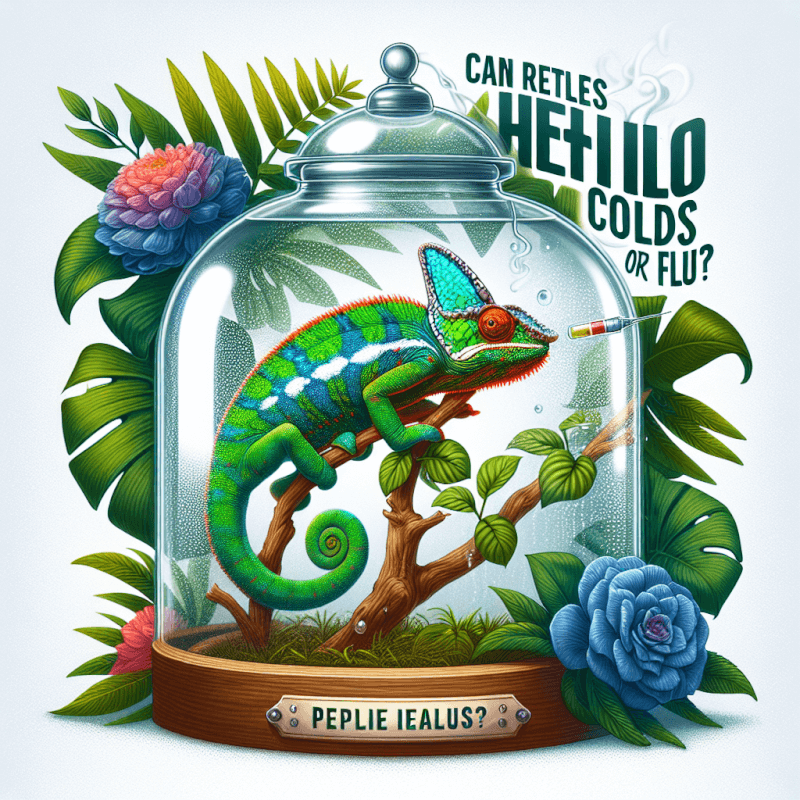Imagine cuddling up on a chilly evening, sipping a warm cup of tea, feeling a bit under the weather. And then it hits you – can reptiles get colds or flu too? You’ve probably wondered about this at some point, whether these scaly creatures can experience those familiar symptoms that make us all reach for tissues and cough drops. Well, get ready to uncover the truth behind reptiles and their susceptibility to these common illnesses. Spoiler alert: it might surprise you!

Overview
Understanding colds and flu
Colds and flu are respiratory infections that commonly affect humans. They are caused by viruses and are characterized by symptoms such as coughing, sneezing, nasal congestion, and sore throat. While these infections are prevalent in humans, you may wonder if reptiles, such as snakes, lizards, and turtles, can also experience similar ailments. In this article, we will explore the possibility of reptiles getting colds or flu, examine their unique respiratory systems, discuss common respiratory infections in reptiles, and provide guidance on prevention and treatment.
Reptile respiratory system
To understand the likelihood of reptiles contracting colds or flu, it is essential to comprehend the unique characteristics of their respiratory system. Unlike humans, reptiles possess a complex respiratory system that differs significantly from ours. This system includes lungs, air sacs, nostrils, trachea, and other specialized structures that allow them to breathe efficiently in their natural habitats.
Respiratory infections in reptiles
Respiratory infections are not uncommon in reptiles and can be a cause for concern among reptile keepers. These infections often occur as a result of improper husbandry practices, including inadequate temperature and humidity levels in their enclosures or exposure to contaminated environments. Understanding the common respiratory infections in reptiles, their symptoms, causes, and available treatments is crucial to ensure the health and well-being of these fascinating creatures.
Can Reptiles Get Colds or Flu?
Colds and flu in humans
Colds and flu, while common in humans, are caused by specific viruses that are primarily adapted to infect human respiratory systems. The viruses that cause these infections target receptors in the human respiratory tract, making it highly unlikely for reptiles to contract the same viruses and experience symptoms similar to those in humans.
Different types of reptiles
Reptiles encompass a wide range of species, each with its own unique physiology and respiratory adaptations. From snakes with elongated and flexible tracheas to turtles with specialized lungs, the respiratory systems of reptiles vary considerably. As a result, the susceptibility to respiratory infections may differ among these different types of reptiles.
Comparison of respiratory systems
The respiratory systems of reptiles and humans have distinct differences that affect their vulnerability to respiratory infections. While humans have a more intricate system with vocal cords and a diaphragm, reptiles have simpler respiratory structures. Additionally, their unique lung and air sac configuration allows for efficient gas exchange, reducing the chances of respiratory infections similar to those observed in humans.

Respiratory System in Reptiles
Unique characteristics
The respiratory system of reptiles exhibits several unique characteristics that set it apart from that of humans. Reptiles have unidirectional airflow, which enables air to flow in one direction through their lungs, ensuring optimal oxygen exchange. They also possess air sacs, which play a crucial role in aiding respiration and provide additional air storage capacity.
Lungs and air sacs
Reptile lungs vary in structure and efficiency compared to those of mammals, including humans. They lack a diaphragm and have limited muscle tissue, resulting in reduced lung capacity. However, the presence of air sacs compensates for this limitation, allowing reptiles to maximize their respiratory efficiency and cope with the demands of their unique lifestyles.
Nostrils and trachea
Reptiles have nostrils that serve as the entrance for air into their respiratory system. The nostrils connect to the trachea, a tube that acts as a conduit for airflow between the throat and the lungs. Unlike humans, reptiles do not possess vocal cords, which further differentiates their respiratory anatomy from ours.
Common Respiratory Infections in Reptiles
Upper respiratory infections
Upper respiratory infections (URIs) are one of the most prevalent types of respiratory infections in reptiles. These infections can be caused by various pathogens, including bacteria and viruses, and typically manifest as nasal discharge, sneezing, and wheezing. URIs can be particularly severe in reptiles if left untreated, leading to complications such as pneumonia.
Pneumonia in reptiles
Pneumonia is a severe respiratory infection that affects reptiles and can be life-threatening if not promptly addressed. It can arise from untreated URIs or be caused by specific pathogens entering the lungs, leading to inflammation and breathing difficulties. Pneumonia in reptiles may exhibit symptoms such as coughing, open-mouth breathing, and lethargy, requiring immediate veterinary attention and intervention.
Mycoplasma infections
Mycoplasma infections are a commonly encountered group of bacterial infections in reptiles. These bacteria can invade the respiratory system, causing chronic respiratory disease and compromising the overall health of the reptile. Mycoplasma infections often present with symptoms such as wheezing, nasal discharge, and weight loss, necessitating veterinary diagnosis and appropriate treatment.

Symptoms of Respiratory Infections
Nasal discharge
One of the primary symptoms of respiratory infections in reptiles is nasal discharge. This can vary in consistency and color, ranging from watery and clear to thick and discolored. Persistent or excessive nasal discharge may indicate the presence of an infection and should be addressed promptly to prevent further complications.
Wheezing or labored breathing
Respiratory infections can cause wheezing or labored breathing in reptiles. If you notice your reptile making unusual sounds while breathing or displaying signs of breathlessness, it could be an indication of a respiratory infection. Prompt veterinary attention is necessary to diagnose the underlying cause and provide appropriate treatment.
Lethargy and loss of appetite
Reptiles with respiratory infections may exhibit lethargy and a loss of appetite. These signs can be indicative of the systemic effects of the infection on the reptile’s overall health. It is essential to monitor your reptile closely for any changes in behavior, eating patterns, or energy levels and consult a veterinarian if you suspect a respiratory infection.
Causes of Respiratory Infections
Bacterial infections
Bacterial infections are a common cause of respiratory infections in reptiles. Poor husbandry practices and unsanitary conditions can increase the risk of bacterial colonization in the respiratory tract. Additionally, stress, overcrowding, or the introduction of infected reptiles can contribute to the spread of bacterial respiratory infections among captive reptiles.
Viral infections
Although reptiles can contract viral infections, these viruses are typically species-specific and may differ significantly from the viruses that cause colds and flu in humans. Reptile-specific viral infections can still cause respiratory symptoms and pose a risk to the affected reptile’s health. Implementing robust hygiene practices and maintaining a controlled and clean environment can help reduce the risk of viral respiratory infections.
Fungal infections
Fungal respiratory infections can occur in reptiles, especially in those housed in overly moist or unsanitary conditions. Certain fungi, such as the causative agents of respiratory infections known as “fungal pneumonia,” can affect the respiratory health of reptiles. Proper habitat maintenance, including appropriate substrate choices and adequate ventilation, can help minimize the risk of fungal infections.

Prevention and Treatment
Proper husbandry practices
Preventing respiratory infections in reptiles starts with providing optimal husbandry conditions. This includes maintaining appropriate temperature and humidity levels, providing a clean and adequately sized enclosure, and offering a balanced diet. Ensuring your reptile has a stress-free environment and access to clean water is also crucial for maintaining respiratory health.
Isolation of sick reptiles
If you suspect that your reptile has a respiratory infection, it is essential to isolate them from other reptiles to prevent the spread of the infection. By keeping the sick reptile in a separate enclosure, you minimize the risk of transmission to healthy individuals. Proper quarantine procedures, coupled with consultation from a reptile veterinarian, can help diagnose the specific respiratory infection and determine the appropriate treatment plan.
Veterinary care and medication
When it comes to the diagnosis and treatment of respiratory infections in reptiles, consulting a reptile veterinarian is imperative. They will perform a thorough examination, potentially including diagnostic tests, to identify the underlying cause of the infection. Treatment may involve administering appropriate medications, such as antibiotics for bacterial infections or antifungal agents for fungal infections, to alleviate symptoms and promote recovery.
Special Considerations for Reptile Keepers
Zoonotic potential of infections
It’s important to note that while reptile respiratory infections are typically not transmissible to humans, some bacterial and fungal pathogens can pose a risk to human health. Reptile keepers should be cautious and practice good hygiene when handling reptiles, their enclosures, or any materials potentially contaminated by respiratory pathogens. Proper handwashing and avoiding direct contact with mucus or respiratory secretions are essential measures to minimize the risk of zoonotic infections.
Personal hygiene
Maintaining personal hygiene is crucial for both reptile health and the well-being of their keepers. Wash your hands thoroughly with soap and water after handling your reptile, cleaning their enclosure, or coming into contact with any potentially contaminated materials. Avoid touching your face or mouth while handling reptiles or their equipment, as it can serve as a route for potential pathogen transmission.
Avoiding cross-contamination
Reptile keepers should take measures to prevent cross-contamination between reptiles, their enclosures, and any equipment used. Use separate tools, such as feeding tongs, for each individual reptile to avoid cross-contamination. Regularly disinfecting enclosures, water dishes, and other items in contact with reptiles can further reduce the risk of respiratory infections spreading within a reptile collection.

Conclusion
In conclusion, while reptiles do not contract colds or flu like humans do, respiratory infections are common in these creatures. The unique characteristics of their respiratory system, including the presence of lungs, air sacs, nostrils, and a trachea, contribute to their susceptibility to various respiratory infections. Proper care, including maintaining optimal husbandry practices, isolating sick reptiles, and seeking veterinary care and medication when necessary, is crucial for preventing, diagnosing, and treating respiratory infections in reptiles. By following these guidelines, reptile keepers can ensure the well-being and respiratory health of their scaly companions.


